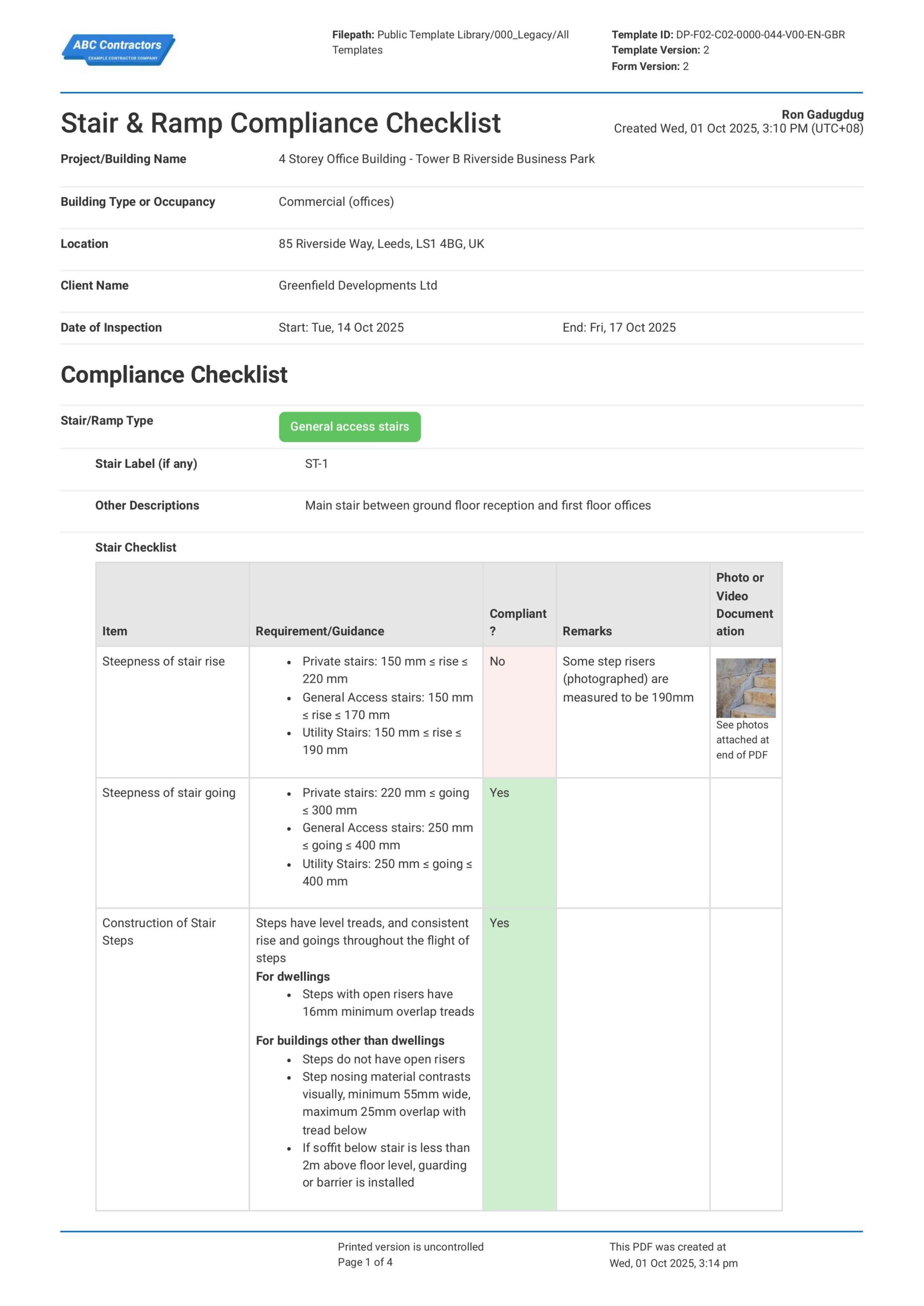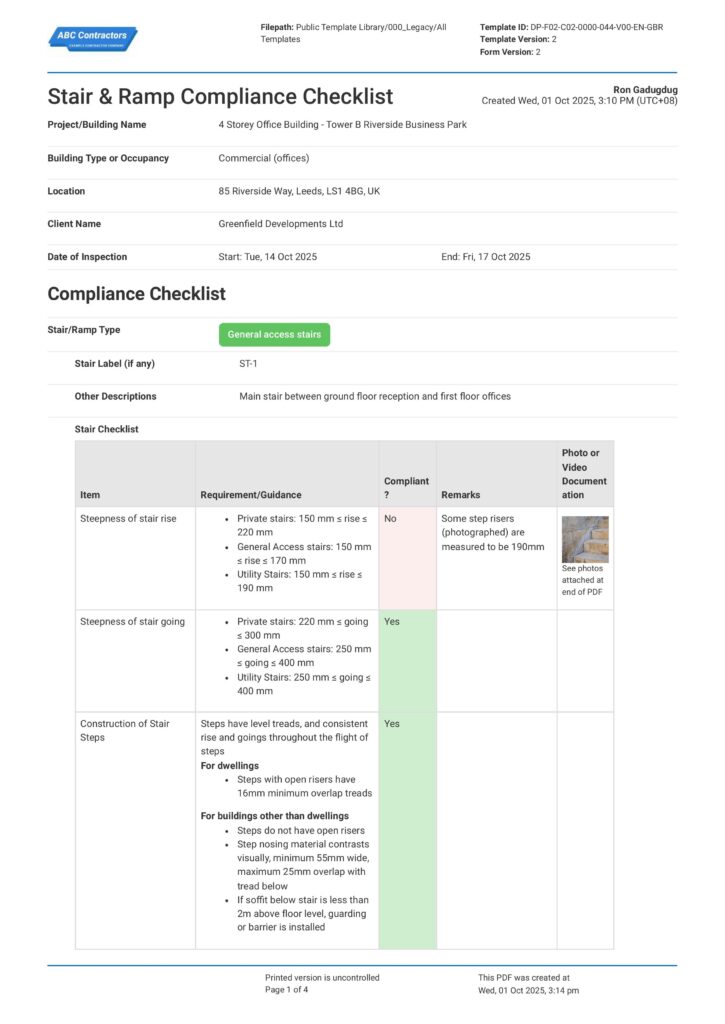Stair & Ramp Compliance Checklist Template
Start with a free 30-day trial. No credit card required.

~10,000 employees
~500 employees
~10 employees
~25,000 employees
~200 employees
~1,500 employees
~20 employees
What is a Stair & Ramp Compliance Checklist?
A Stair & Ramp Compliance Checklist is a form where engineers check off important points when constructing and inspecting stairs and ramps. Ensuring safe accessible passageways is critical for the well-being of its users, specifically stairs or ramps that serve as escape routes, or intended passageways for persons with disabilities.
Whether your team is based in England or in Wales, stair and ramp construction standards are regulated by the Approved Document K, or Part K, of the UK Building Regulations. In this context, a stair and ramp compliance checklist also helps demonstrate that the stair or ramp in question is compliant with these regulations.
Compare this Stair & Ramp Compliance Checklist with other traditional formats (Word or PDF)
Use this Stair & Ramp Compliance Checklist template for free.
Why is Stair & Ramp Compliance Important?
Complying with stair & ramp regulations is important because it ensures the safety of the people who use it. Slips and falls on these passageways are one of the leading causes of injury to the elderly demographic and disabled people around the world.
In the UK alone, stair slips and falls in adult homes cause nearly 600 deaths and 350,000 injuries per year, costing the NHS nearly £435 million in damages.
In response to this, building regulators in the UK set out to control the quality of build of these stairs and ramps by issuing industry regulations in the Approved Document K. Among these regulations are that stairs and ramps must be constructed with consistent step dimensions, safe ramp gradients, effective guarding and handrail placements, ample headroom allowance, and are clear of obstructions and other hazards.
Different Types of Stairs & Ramps You Should Know for the Checklist
Not all stairs and ramps were created equally. There are different types of stairs and ramps that serve different purposes for different users. In order for you to determine which kind of stair or ramp is suited for your need, you should be aware of the following types:
- Private stairs – Stairs intended for homes or other single dwellings. Typically have more flexible or relaxed regulations that pertain to its construction.
- General access stairs – Stairs used by the public or occupants of a building. Typically, these types of stairs are designed to meet stricter safety and accessibility standards.
- Utility stairs – Secondary stairs meant to be used for maintenance or access to restricted areas typically found in commercial or industrial buildings. Limited use allows for relaxed dimension requirements.
- Spiral or helical stairs – Stair type valued for its space-saving design due to its curved treads. Typically has stricter regulations to address dimensions, rise & goings of the treads.
- Alternating tread stairs – Compact stairs with staggered treads, only permitted in spaces with very limited access, such as lofts
- Access ramps – Sloped routes that provide step-free access, with regulations for maximum gradient, width, and landings.
Safe Stair & Ramp Design: Important Key Terms
When reviewing the Approved Document K Wales, you will find that it uses words like “rise & going” or “gradients” when describing dimensions of stairs and ramps. Here’s a quick list of some important terminology used in the Part K PDF that you should know about:
- Rise – The vertical height of each step
- Going – The horizontal depth of each step
- Stair width – The clear width across a stair, set depending on expected traffic
- Headroom – The minimum vertical clearance above stairs or ramps to prevent bump hazards
- Ramp gradients – The slope ratio of a ramp, usually calculated by dividing the rise value of the going value (rise/going)
- Handrails – Supports that are fixed at set heights for users to grip, which aids stability and prevents falls
- Guarding – Barriers such as balustrades that prevent people from falling from stairs, ramps, or landings
Frequently Asked Questions
Why is this the best Stair & Ramp Compliance Checklist template?
Sitemate’s Stair & Ramp Compliance Checklist template comes ready with the exact regulation for each inspection item, right there on the form, so you won’t have to keep reading through the Part K document when performing inspections. Plus, you can even write down inspection notes, attach photos for each checklist item, and even perform sign-offs via e-signatures – all on one form.
Does this checklist comply with important building codes?
Yes, this checklist was created based on the exact regulations and requirements set out in Part K, or Approved Document K, of the UK Building Regulations.
How do I edit the pre-filled content of the checklist?
Editing and creating your own checklist forms are quick and easy with Dashpivot’s no-code template builder. Add, remove, or edit any portion of the template to tailor-fit your company’s exact needs. You can even add your company logo and custom letterhead.
Where will I be able to access the checklists I create?
You can access your checklists on any device. That means you can build your own checklist template on your office computer, take that checklist with you on your phone for site visits where you fill it out, then access it again on a laptop or desktop for final edits and sign-offs.
Other popular templates you can use and edit for free

Glazing Safety Log
Log all glazing activities across projects and keep track of progress.

Approved Document K Report
Ensure your team stays compliant with the UK Building regulations with this easy-to-use checklist

Ramp Gradient Checklist
Keep ramps in dwellings at the standard angle and maintain safety standards.
This checklist was generated with Dashpivot software
Technology is the edge you need to stay on top of your work tasks. Take advantage of digital tools and streamline your workflow with Dashpivot.
- Access, edit and complete stair & ramp compliance checklists from any device - mobile, tablet or computer.
- Print, download or send your compliance checklists as perfectly formatted PDF documents with your company logo.
- Store your checklists securely online, where they can be searched and found in seconds
- Invite internal and external parties to see, edit and sign off on checklists online.

Sitemate builds best-in-class software tools for built world companies.



